How Much Money Does California Make From Using Bees To Pollinate
Carpenter bees derive their name from their ability to drill perfectly round holes in exposed wood to make nests. The bees drill and burrow 1/2 inch bore holes using their strong broad mandibles (jaws).
They take many interesting attributes, traits, and habits. Some of which are not very popular with homeowners! Let's dig (pun intended) into some interesting facts about carpenter bees.
1. Carpenter bees don't swallow wood
Carpenter bees don't eat woods for nutrition; they merely chew into dead only non-decayed limbs or trunks of standing dead trees to drill holes.
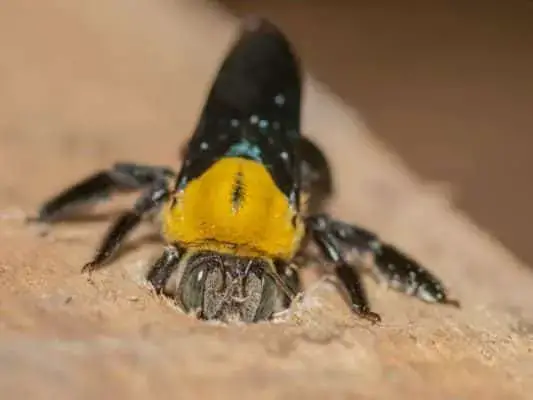
They also relish timber structure with weathered, unpainted woods especially softer varieties such equally redwood, cedar, cypress, and pine. They take powerful pointy mouthparts as well known equally mandibles; which they use to drill and tunnel through even the tough plants such as bamboo.
Insects rely on their mandibles to grasp things and pick them upward, or for more user-friendly activities similar cutting up plants and food, edifice nests, and digging through dirt.
By positioning her body on a wooden surface, the female carpenter bee goes to work drilling holes. She rasps her mandibles confronting the woods and vibrates, tearing through the woods's fibers post-obit a round pattern. She patiently removes one small piece at a fourth dimension.
It takes a few days for a small hole to form that'southward only i/two inch in diameter, just big enough for the bee to squeeze into. The drilling process generates sawdust that the bee after reuses when building and partitioning galleries in the tunnel to shop her eggs.
2. There Is No Queen Carpenter Bee
Carpenter bees are alone insects and do not live in colonies like dear bees. They don't have a caste social system where you would discover a task specific gild such as in eusocial insects; bumblebees or honey bees. There are no queen or worker castes.
The adults live a lonely life but the females can share a nest. They overwinter individually, near times in previously constructed brood tunnels where they have stored express pollen to survive the colder temperatures.
3. Male Carpenter Bees Fight Dirty, Including Head butts
Male carpenter bees are territorial. They appear to exist aggressive as they fly effectually people and pets, only they are harmless since they practise not have a stinger. They stake out and protect their territory from other carpenter bees and predators.
They can swoop-bomb your head and buzz around a short distance in forepart of your confront if yous arroyo their nests besides closely.
These deportment are just a show meant to intimidate and drive off intruders and other carpenter bees from a territory. When they fight other male person carpenter bees they head butt in mid-flight crashing into each other. Because of their big size, they appear quite threatening when they perform these maneuvers.
iv. Female Carpenter Bees Are Expert Engineers
To build their nests, they first drill a hole of 1/two inch in bore in wood, preferably thick wood of more than ii inches width. Information technology takes 5 to 6 days for the female carpenter bee to drill and excavate just i inch of wood.
The Penn Land Higher Of Agricultural Sciences has some interesting research insights into the applied science feats of these insects as they work on wood.
The female person carpenter bee can squeeze through incredibly tiny places to bore into untreated forest. They brand a 90 caste plough after drilling and excavating holes of 1 to ii inches, then they drill a tunnel parallel to the wood surface. The tunnel runs along the wood grain to form a gallery virtually 6 inches long.
This gallery tin sometimes be up to four feet long or more because carpenter bees accept a tendency to come back twelvemonth after year, to the same nest sites. They can excavate and expand the same site quite extensively to form galleries.
The long channel later the correct angle plough serves equally the principal corridor from which she will drill small chambers a few inches deep which become egg holders.
In each sleeping accommodation, she will deposit an egg on elevation of a mass of pollen and regurgitated nectar. She will then seal off the bedchamber to ensure the egg'south further development. The female bee forms partitions betwixt each egg jail cell past mixing sawdust and saliva.
The partition walls closely resemble particle boards. Working back to front end, the bee leaves each prison cell with a ball of pollen and a single egg.
5. Carpenter Bees Live In A Family Dwelling, Sort Of…
Although carpenter bees are traditionally considered as solitary insects, some species conjugate in unproblematic social nests, but just mothers and daughters may cohabit.
Two species seen to exhibit this social nesting behavior are Xylocopa sulcatipes (Arabian bee) and Xylocopa nasalis (widely establish in Southeast Asian countries).
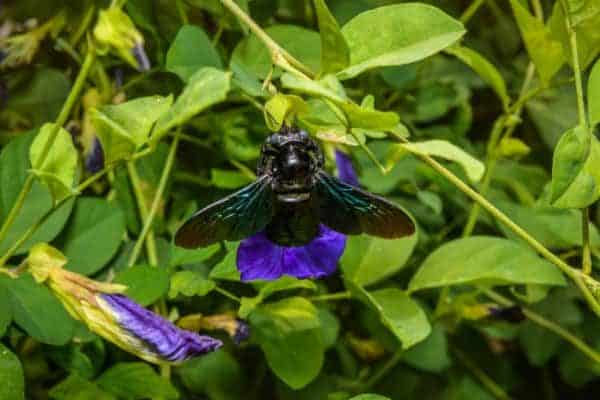
6. How Y'all Can Tell You Accept A Carpenter Bees Nest
Carpenter bees usually notice their favorite sites for drilling holes on the unpainted underside of any wood surface including fascia boards, overhangs, soffits and window frames, outdoor furniture, and eaves. Other places are rafters, siding, wood shake roofs, and decks.
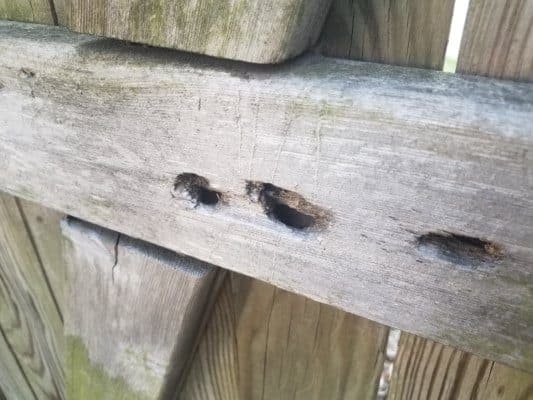
Underneath the round holes that the bees drill you lot will see coarse sawdust-similar substances chosen frass. Yous may observe one-time holes almost the newer ones that the carpenter bees can use yr later year.
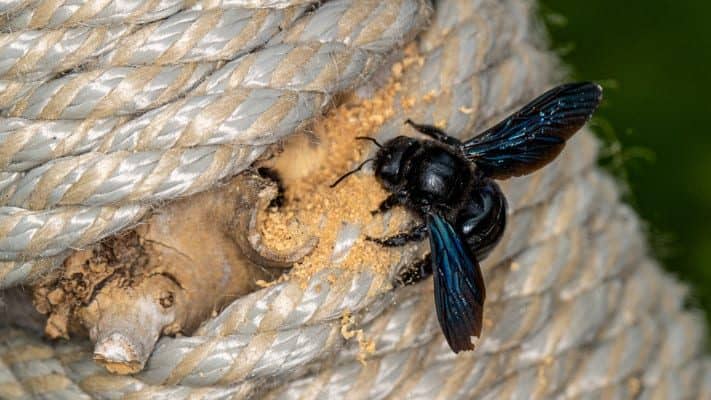
More signs are brownish or yellow excrement stains below the archway hole to the galleries. As well if you lot find many bees hovering around wooden or timber structures, specially if they are not painted, information technology could exist a sign of carpenter bees infestation.
Nosotros have an article that discusses in particular how carpenter bees drill holes and the risks to the structures around your property that carpenter bees tin can pose. The article is called, How Do Carpenter Bees Drill Holes? Information technology's Worse Than You Recollect
7. Can Carpenter Bees Crusade Structural Damage To Your Firm?
Carpenter bees are non considered a true structural pest because they do not spread throughout the entire structure. For case, termites are quite destructive on woodwork.
Carpenter bees tend to infest the same pieces of timber twelvemonth after year, and because they excavate and expand the galleries in the woods, this can occasion significant harm.
Holes in the wood can allow moisture intrusion, rot, and disuse. The big larvae developing in the wood tunnels attract woodpeckers who seek out the larvae and cause more than damage.
The woodpecker's peck and drill holes along the tunnels to get at the bees and larvae. The other natural predators of the bees are bird species such as shrikes and bee-eaters.
In the curt term, the harm created past carpenter bees is more cosmetic than structural; however if not treated in time serious impairment can happen over the years as the bees go on coming back and expanding the nests.
To detect out more about How Do Carpenter Bees Drill Holes? It's Worse Than You Think, follow the link for detailed information.
8. Carpenter Bees Vibrate To Pollinateast
When it comes to the pollination of plants, few insects on the planet tin match the love bee species prowess as pollinators; however, the carpenter bee also plays a significant role in pollination.
Every bit Pollinators, carpenter bees are important on some open-faced or shallow flowers. They are excellent pollinators of eggplant, tomato, and other vegetables. They are generalists in the pollination of our vegetable and blossom gardens and may be found foraging on a number of different species.
They are early on morning foragers, simply like bumblebees. For some flowers they are fifty-fifty obligate pollinators, significant they are the only insects that pollinate these plants. Some examples of such plants are maypop, purple passion, and opium (bounding main rose) which are non pollinated by any other insects.
Carpenter bees use their powerful thoracic muscles to sonicate the dry pollen grains out of the flowers' anthers. This type of pollen gathering is called 'buzz pollination", with bees landing on blossom blossoms condign similar living tuning forks. This activeness shakes loose pollen grains that end up sticking on the bees' hairs.
The Carpenter bees have short mouthparts; hence they cannot reach the nectar of long tubed flowers. Besides due to their large size, they are unable to enter the flower openings of certain flowers such every bit salvias, penstemons, and other long tubular flowers.
So the carpenter bee resorts to ingeniously robbing the nectar. Using their mouthparts they cut a slit at the base of the corolla and steal abroad with the nectar.
In this process, more often than not, they don't pollinate the flower because they miss contact with the anthers that hold pollen.
We have an entire article dedicated to how bees pollinate plants if you lot are interested. We as well comprehend what flowers are doing to concenter bees and how bees are seeing flowers. The article is called, How Exercise Bees Pollinate?
9. Mating Trends/System
The males seek out the females during bound and can exist seen hovering around nests. All females are fertile and tin can mate. The species Xylocopa Varipuncta, widespread in the western United States, has an unusual mating organization.
The males are green-eyed and aureate while the females are all blackness and have huge glands in their thoraces.
Territorial males cull not-flowering plants about other males and take upwardly positions. They then every bit a grouping, actively release their rose-scented alloy of chemicals. This attracts females from downwind who so choose a male person with which to mate.
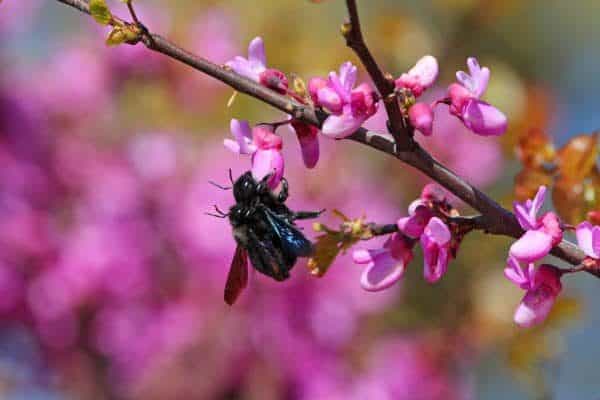
Fertilized female carpenter bees then bore into forest, excavating galleries to lay their eggs. The eggs hatch and mature in nigh 36 days.
The stored pollen serves as a food source for the developing larvae. The new mature generation of developed bees emerges in summer and begins foraging on flowers.
10. Carpenter Bees Sting, Simply It Is Rare. This Is Why
These bees are more often than not non-aggressive and for the most function, heed their own business organisation without being a threat to people.
The females do sting although information technology is very rare. The bees stay near the nests which concur their eggs. You are unlikely to encounter them unless you disturb their nest which they stay close to.
Unless handled or provoked excessively they will not sting a person or pet. Female carpenter bees are able to sting more one time and their stingers practice incorporate venom.
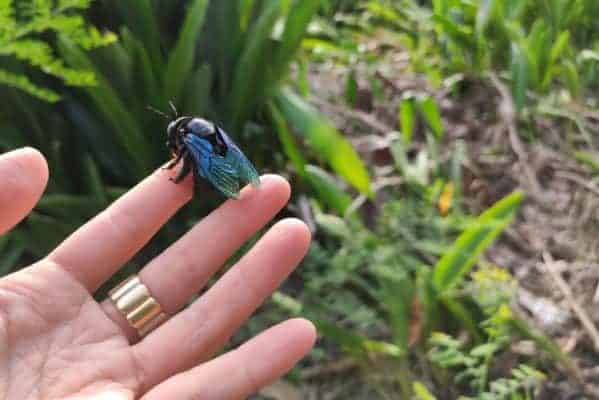
They do non lose their stingers after the assault and they tin sting multiple times if the threat/intruder remains in the vicinity of the nest. It is all-time to stay away from their nests especially in spring and summer.
Endeavour not to make any sudden movements if a carpenter bee lands on yous. Merely remain calm and wait for the bee to wing away. Their sting is equally painful as any other type of bee.
We take a deep dive into this topic of carpenter bees and their stings in another article that would exist worth a expect if you are interested. The article is called, Do Carpenter Bees Sting And Does It Hurt?
11. Carpenter Bees Eat Pollen and Nectar
Like nigh other bee species, carpenter bees forage for pollen and nectar from flowering plants. The pollen and nectar provide them with their poly peptide and carbohydrate sources.
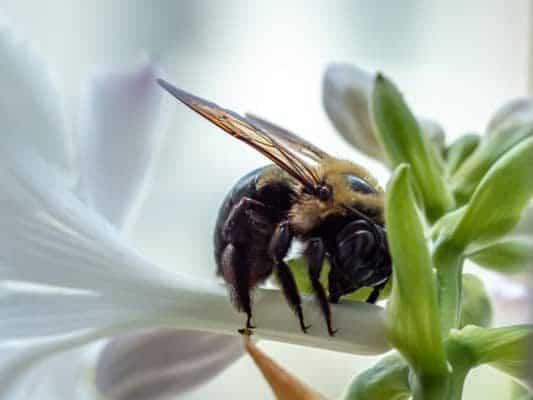
However, unlike the dearest bees, they don't make or store honey in their nests. Carpenter bees regurgitate nectar and mix it with pollen. The result is a brawl of thick and denser "bee staff of life" than their smaller cousins, the beloved bee species which make honey.
It has a cookie dough consistency, more like peanut butter. They leave the pollen and love assurance in the egg cells for the larva to feed on upon hatching. They usually regurgitate the nectar from flowers and mix information technology with pollen to form bee-bread.
12. Carpenter Bees in The U.s. Are In Two Genera
In the Usa, carpenter bees are categorized into two genera—large carpenter bees (Xylocopa) and small carpenter bees (Ceratina).
Xylocopa
Due to their habit of drilling and excavating holes and tunnels in forest, the Xylocopa are the amend known species, more than than Ceratina.
The geographical distribution of the big carpenter bees in the The states covers the eastern and western, and parts of the southern U.s..
In the Eastern part of the country, you lot will find the Xylocopa Virginica and Xylocopa Micans species. By far the nigh widely distributed species is 10.virginica.
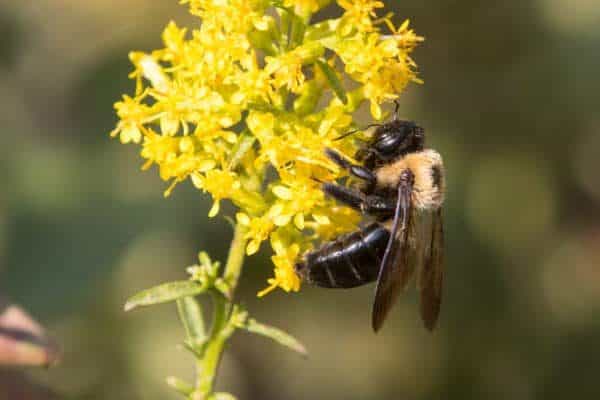
In the western United states, three more species are primarily ascendant in distribution; X.sonorina, X.tabaniformis Opifex, and X.Californica. All these species are in the genus of large carpenter bees.
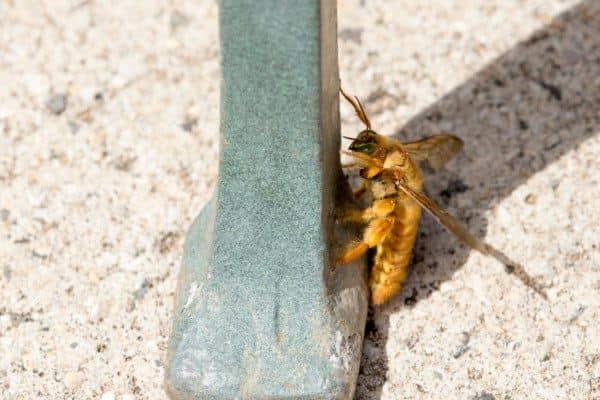
This is a male person Sonorina Carpenter Bee (Xylocopa sonorina) plant in the western The states.
Ceratina
This cosmopolitan bee genus is more often referred to as the small carpenter bee and information technology is closely related to the more familiar carpenter bees.
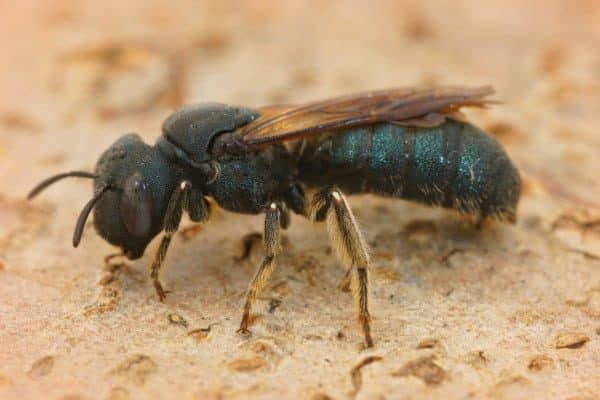
They are usually dark, shiny, even metallic, with fairly thin body hairs and weak pollen carrying apparatus (scopa). They are mainly solitary and make nests in deadwood, stems, or pith.
They take however been known, in some cases, to live in a subsocial setup; with mothers caring for their larvae, and in some few instances where multiple females are found in a single nest. Daughters or sisters may form very pocket-sized weakly eusocial colonies.
This ways one bee forages and the other remains in the nest and lays eggs. The males guard the nests.
xiii. Ceratina Carpenter Bees In Eastward Africa
In East Africa, more than 20 species of the small carpenter bees have been recorded, with 3 of the almost common species of Ceratina being; Ceratina Lineola, Ceratina Lunata, and Ceratina Rufigastra.
In this region, the name bee is thought but to apply to honey bees and local people ordinarily tend not to recognize carpenter bees every bit useful insects.
The carpenter bees are ordinarily shiny black or metallic blueish. They are mostly well sclerotized (armored) and robust.
They can exist found in a wide range of habitats in Eastward Africa such equally natural forests, wetlands, marshlands, open habitats, protected areas, rangelands, farmlands, woodlands, woodlots (wood plantations), and riparian areas.
Quite interestingly, most species institute in E Africa nest in self-fabricated tunnels in woody materials on the ground, in walls of abased houses, or in the soil. Every bit pollinators, most Ceratina bees in East Africa collect nectar and pollen from varying flowering crop species belonging to unlike plant families (are polylectic).
A few visit a narrower range of plants (are oligolectic). Among the plants and crops visited and efficiently pollinated are beans, cowpeas, simsim (sesame), apples, and coffee.
These bees besides visit shrubs, trees, herbs, and lianas found in different habitats. The carpenter bee has a preference for visiting institute species with modest yellow, white, green, milk-cream, and purple colored flowers.
14. Carpenter Bees Are Oftentimes Called Black Bees
In the United States, carpenter bees tend to be blacker than xanthous and have a smooth shiny abdomen. They also accept thick black hair on their hind legs.
Almost species are all black or primarily black with some xanthous or white markings. The top surface of the abdomen is mostly bare and shiny.
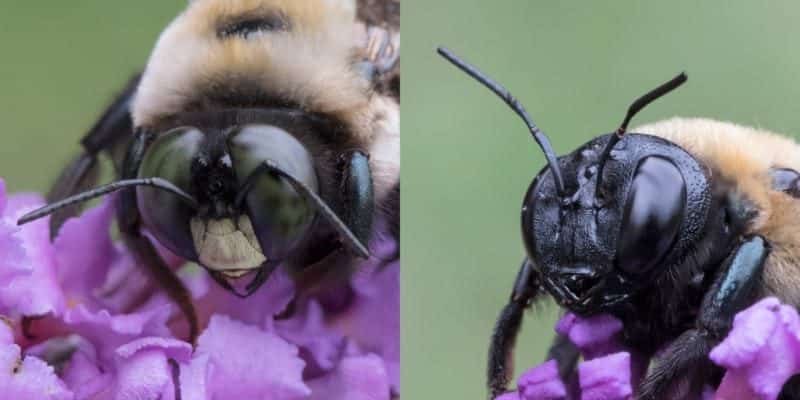
The male eastern caperenter bee (Xylocopa Virginica) has a yellowish fur with a white marking on their face. The females' face up is black. Some species are also blueish-blackness, light-green, or have a purple metallic sheen with a shiny, almost hairless belly.
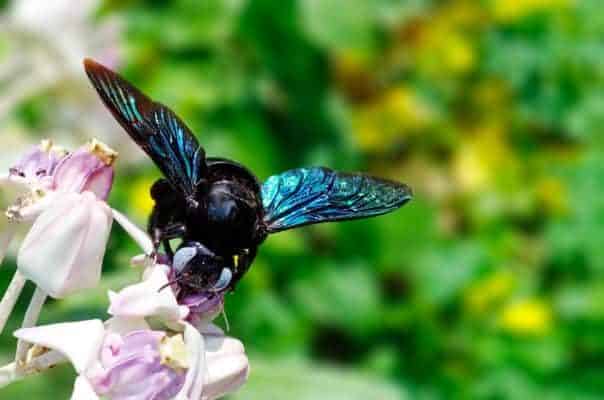
We actually have a full article discussing everything you might need to know most black bees. The article is Blackness Bees, Yous Need To Know The Skilful From The Bad.
15. Carpenter Bees Likewise Come up In Blue
Numerous species of carpenter bees inhabit a broad range of ecosystems, from tropical, subtropical to temperate.
The blue carpenter bee is found throughout Southeast Asia, India, and southern Communist china. They are known for being large and heavy and have the aforementioned behavioral characteristics as solitary bees.
They tin reach upward to (0.91 inches) 23mm. in length. The light blue hairs (pubescence, the scientific proper name for fuzz) covering the thorax region of this insect give it a striking blueish color.
The sides of the abdomen are also covered by similar, though a finer and thinner coat of blueish hairs. The males have a more subdued brown or greenish fuzz.
16. Carpenter Bees Live For About a Year
Carpenter bees are long lived and can exist expected to live for far much longer than the honey bee species under normal circumstances.
Carpenter bees spend an average of 2 days as an egg, 15 days as larva, four days in the pre-pupa stage, and 15 days as a pupa.
Adults emerge in August, feed, and so return to the aforementioned tunnel to overwinter and begin the process over. The"expected" lifespan of a carpenter bee is ane year. Even so, the bees may live for upward to three years, with some having two generations living in the same nests.
We accept an in-depth commodity that compares the life cycles of carpenter bees with both dear bees and bumblebees. The commodity is Carpenter Bees Vs Bumblebees Vs Dear Bees.
The Wrap Upward
Carpenter bees are important pollinators of both native and agricultural plants in many parts of the world. Their benign office as pollinators far outweighs their destructive habits of drilling holes and nesting in our homes and outdoor furniture.
By doing preventive maintenance, most of the serious damage acquired by these bees to our homes can be prevented.
Painting or applying wood varnish, caulking, and sealing off all crevices and spaces are some unproblematic steps you tin can take to go on off potentially destructive bees.
They play a significantly useful role in (though at times non recognized) our ecosystems and their wide geographical presence in different habitats attests to this fact.
These gentle giants are commonly confused with bumblebees, merely the simplest way of telling them autonomously is by noting that most carpenter bees have shiny abdomens, whereas bumblebees are completely covered by dumbo hair.
They are non-ambitious and moderately defensive. They don't pose much of a threat if left alone. They simply listen their own business of pollinating plants and building nests.
References
https://www.westernexterminator.com/blog/buzz-carpenter-bees/
https://www.orkin.com/stinging-pests/bees/carpenter-bee
https://en.wiktionary.org/wiki/polylectic
https://www.encyclopedia.com/scientific discipline/dictionaries-thesauruses-pictures-and-printing-releases/oligolectic
https://www.fs.fed.united states of america/wildflowers/pollinators/pollinator-of-the-calendar month/carpenter_bees.shtml
Source: https://whatbugisthat.com/16-facts-about-carpenter-bees-you-need-to-know/
Posted by: martinmothasaim.blogspot.com

0 Response to "How Much Money Does California Make From Using Bees To Pollinate"
Post a Comment